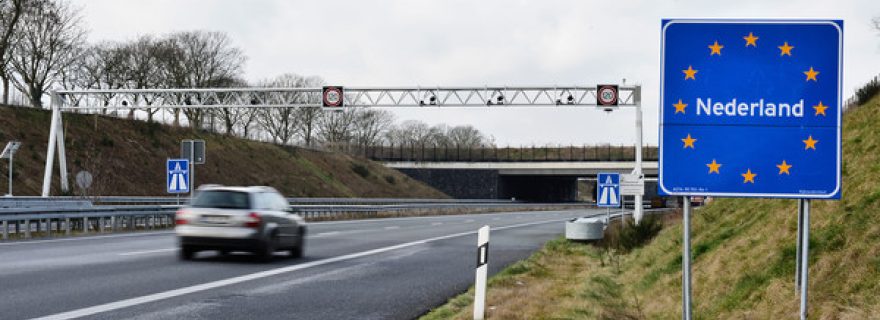The Myth of the 'Open' Border
The real myth of borders is not that they are open or that control thereof is beyond our capacities, but that movement is somehow ‘free’. Moving across borders entails exercising privileges, and these privileges are not distributed equally.
The issue of borders and especially how to control them became a major theme in the wake of the 2015 migrations to Europe and the November attacks in Paris that same year. However, it is hardly a new discussion. For decades, the idea of open borders has been associated with the notion of a globalizing world in which transnational economic and financial flows have reduced the importance of territorial frontiers. Cross-border movement, whether concerning goods, services, capital or persons travelling for business, leisure or educational purposes, is seen as instrumental in order to sustain today’s livelihoods. Data visualizations of flight patterns and ship movements provide a glimpse of the global scale of movement. But unparalleled movement has been also associated with concerns: it benefits terrorist and criminal networks who can operate across borders, making it harder for governments constrained by their respective jurisdictions to act against them. This is a familiar line of argumentation, but one that also overlooks how border control functions in many places.
Scholars in Border Studies have moved beyond the view of borders as territorial markers or ‘lines in the sand’ functioning by a logic of either openness or closure. They argue that we should look at the regulation of movement instead. There is no denying that in certain places the significance of (territorial) borders has diminished - the Schengen Zone is a case in point. At the same time, however, new forms of border control have appeared, although – and this is a key aspect – not always where we would expect to find them. The underlying premise of border control arrangements is to regulate inclusion and exclusion: who or what can enter and under what conditions. The purpose is to filter between desired and undesired elements. Scholars call this the facilitation/control dilemma: some cross-border flows are speeded up and facilitated through less or quicker checks, while others are subjected to closer scrutiny so their entry can be blocked if needed.
The facilitation of movement takes many forms and can be found in many places. Think of so-called trusted traveler schemes such as Schiphol’s Privium. This subscription-based service allows frequent flyers to circumvent busy border control lines at airports by taking specially designated lanes operated by iris scan. Other examples include the attraction of highly-skilled, non-EU workers via the EU’s Blue Card Directive; EU preferential trade agreements with a number of countries across the globe based on reduced tariffs to promote economic exchange (as this infographic shows); or visa free travel arrangements that enable citizens to travel with less administrative hassle compared to those from African or Asian countries. Desired movement is not a natural phenomenon per se, it is also (strongly) promoted by governments.
Yet, these examples do not fully classify as ‘open borders’ since there are criteria to be met in order to travel ‘freely’. Qualifying for the Blue Card requires a salary that is 1.5 times the average gross annual salary of the EU country where the person intends to work - an incredibly high benchmark for many non-EU citizens, even for those with university degrees. Agreements on preferential trade are the outcome of (protracted) negotiations about which products and services to include and under what conditions. Requesting visas still involves a process of registration, including in some countries a visit to the consulate and/or the paying of a fee. Visas inevitably come with (strict) conditions in terms of the length of stay, and can even involve legal or administrative consequences in case of overstaying. Rather than to speak of free movement, it is the focus on the regulation of such movement that reveals a multiplicity of practices aimed at the filtering and sorting of movement.
Even asylum-seeking fits this principle. While states are obliged under international law to (temporarily) offer shelter and the possibility of asylum to people having a ‘well-founded fear of being persecuted’, such claims are scrutinized, and many states have substantial rejection rates of asylum claims. For instance, the Netherlands dismissed 44% of the claims in 2016 and 80% in 2018.
Another example of how movement is regulated pertains to the EU’s largest database for law enforcement purposes, the Schengen Information System (SIS). The latter was devised as a way of compensating for the removal of internal border controls. SIS contains so-called alerts on objects and persons – 82.2 million in 2018. These alerts are entered by law enforcement for specific purposes, e.g. a person is missing or wanted, or an object is stolen. If, for instance, a wanted person crosses into another member state and is stopped by police, a consultation of SIS would reveal the alert and the officers can follow up on any listed instructions, including arrest. Thus, in the cross-border movement facilitated by the EU, SIS equips police forces with some form of control against cross-border crime.
The real myth of borders is not that they are open or that control thereof is beyond our capacities, but that movement is somehow ‘free’, a prominent objective of the EU. Instead, moving across borders entails exercising privileges, and these privileges (that is to say, cultural, political, social and financial capital) are not distributed equally. Besides, borders remain heavily regulated – even so in the EU –, as criteria need to be met to cross them.


